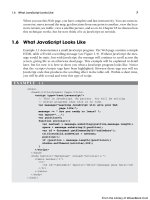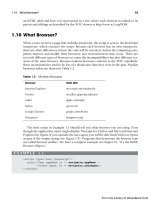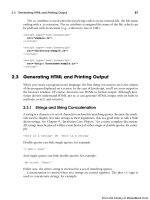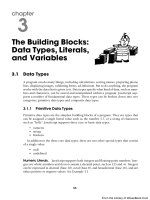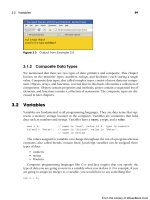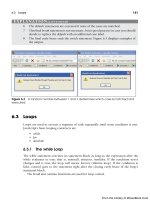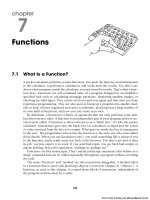Học JavaScript qua ví dụ part 8 ppsx
Bạn đang xem bản rút gọn của tài liệu. Xem và tải ngay bản đầy đủ của tài liệu tại đây (935.77 KB, 9 trang )
ptg
3.2 Variables 59
3.1.2 Composite Data Types
We mentioned that there are two types of data: primitive and composite. This chapter
focuses on the primitive types: numbers, strings, and Booleans—each storing a single
value. Composite data types, also called complex types, consist of more than one compo-
nent. Objects, arrays, and functions, covered later in this book, all contain a collection of
components. Objects contain properties and methods, arrays contain a sequential list of
elements, and functions contain a collection of statements. The composite types are dis-
cussed in later chapters.
3.2 Variables
Variables are fundamental to all programming languages. They are data items that rep-
resent a memory storage location in the computer. Variables are containers that hold
data such as numbers and strings. Variables have a name, a type, and a value.
num = 5; // name is "num", value is 5, type is numeric
friend = "Peter"; // name is "friend", value is "Peter",
// type is string
The values assigned to variables can change throughout the run of a program whereas
constants, also called literals, remain fixed. JavaScript variables can be assigned three
types of data:
• numeric
• string
• Boolean
Computer programming languages like C++ and Java require that you specify the
type of data you are going to store in a variable when you declare it. For example, if you
are going to assign an integer to a variable, you would have to say something like:
int n = 5;
Figure 3.3 Output from Example 3.4.
From the Library of WoweBook.Com
ptg
60 Chapter 3 • The Building Blocks: Data Types, Literals, and Variables
And if you were assigning a floating-point number:
float x = 44.5;
Languages that require that you specify a data type are called “strongly typed” lan-
guages. JavaScript, conversely, is a dynamically or loosely typed language, meaning that
you do not have to specify the data type of a variable. In fact, doing so will produce an
error. With JavaScript, you would simply say:
n=5;
x = 44.5;
and JavaScript will figure out what type of data is being stored in n and x.
3.2.1 Valid Names
Variable names consist of any number of letters (an underscore counts as a letter) and
digits. The first character must be a letter or an underscore. Because JavaScript keywords
do not contain underscores, using an underscore in a variable name can ensure that you
are not inadvertently using a reserved keyword. Variable names are case sensitive; for
example, Name, name, and NAme are all different variable names. Refer to Table 3.2.
3.2.2 Declaring and Initializing Variables
Variables must be declared before they can be used. To make sure that variables are
declared first, you can declare them in the head of the HTML document. There are two
ways to declare a variable: with or without the keyword var. Although laziness might get
the best of you, it is a better practice to always use the var keyword.
You can assign a value to the variable (or initialize a variable) when you declare it,
but it is not mandatory, unless you omit the var keyword. If a variable is declared but
not initialized, it is “undefined.”
Table 3.2 Valid and Invalid Variable Names
Valid Variable Names Invalid Variable Names
name1 10names
price_tag box.front
_abc name#last
Abc_22 A-23
A23 5
From the Library of WoweBook.Com
ptg
3.2 Variables 61
To declare a variable called firstname, you could say
var first_name="Ellie"
or
first_name ="Ellie";
or
var first_name;
You can declare multiple variables on the same line by separating each declaration
with a comma. For example, you could say
var first_name, middle_name, last_name;
FORMAT
var variable_name = value; // initialized
var variable_name; // uninitialized
variable_name; // wrong
EXAMPLE 3.5
<html>
<head><title>Using the var Keyword</title>
<script type="text/javascript">
1 var language="English"; // Variable is initialized
2 var name; // OK, undefined variable
3 age; // Not OK! var keyword missing ERROR!
</script>
</head>
<body bgcolor="silver">
<big>
<script type="text/javascript">
document.write("Language is " + language + "<br />");
document.write("Name is "+ name + "<br />");
4 document.write("Age is "+ age + "<br />");
</script>
</big>
</body>
</html>
EXPLANATION
1 The variable called language is defined and initialized. The var keyword is not re-
quired here, but is recommended.
2 Because the variable called name is not initialized, the var keyword is required here.
Continues
From the Library of WoweBook.Com
ptg
62 Chapter 3 • The Building Blocks: Data Types, Literals, and Variables
3.2.3 Dynamically or Loosely Typed Language
Remember, strongly typed languages like C++ and Java require that you specify the type
of data you are going to store in a variable when you declare it, but JavaScript is loosely
typed. It doesn’t expect or allow you to specify the data type when declaring a variable.
You can assign a string to a variable and later assign a numeric value. JavaScript doesn’t
care and at runtime, the JavaScript interpreter will convert the data to the correct type.
Consider the following variable, initialized to the floating-point value of 5.5. In each suc-
cessive statement, JavaScript will convert the type to the proper data type (see Table 3.3).
3 The variable called age is not assigned an initial value. The var keyword is re-
quired. Without it, the program produces errors, shown in the output for Firefox
and Explorer, in Figure 3.4 and Figure 3.5 (on page 63), respectively.
4 This line will not be printed until the variable called age is defined properly. Just
use the var keyword as good practice, even if it isn’t always required!
Figure 3.4 Firefox error (JavaScript Error Console). The variable age was
referenced twice on lines 6 and 16 in the actual program (lines numbered 3 and 4
in Example 3.5). Program was tested twice.
EXPLANATION ( CONTINUED)
From the Library of WoweBook.Com
ptg
3.2 Variables 63
Figure 3.5 Internet Explorer error (Example 3.5).
Table 3.3 How JavaScript Converts Data Types
Variable Assignment Conversion
var item = 5.5;
Assigned a float
item = 44;
Converted to integer
item = "Today was bummer";
Converted to string
item = true;
Converted to Boolean
item = null;
Converted to the null value
From the Library of WoweBook.Com
ptg
64 Chapter 3 • The Building Blocks: Data Types, Literals, and Variables
EXAMPLE 3.6
<html>
<head><title>JavaScript Variables</title>
1 <script type="text/javascript">
2 var first_name="Christian"; // first_name is assigned a value
3 var last_name="Dobbins"; // last_name is assigned a value
4 var age = 8;
5 var ssn; // Unassigned variable
6 var job_title=null;
</script>
7 </head>
8 <body bgcolor="lightgreen">
<big>
9 <script type="text/javascript">
10 document.write("<b>Name:</b> " + first_name + " "
+ last_name + "<br />");
11 document.write("<b>Age:</b> " + age + "<br />");
12 document.write("<b>SSN:</b> " + ssn + "<br />");
13 document.write("<b>Job Title:</b> " + job_title+"<br />");
14 ssn="xxx-xx-xxxx";
15 document.write("<b>Now SSN is:</b> " + ssn , "<br />");
</script>
<p>
<img src="Christian.gif" /></body>
</p>
</big>
</body>
</html>
Output:
10 Name: Christian Dobbins
11 Age: 8
12 SSN: undefined
13 Job Title: null
15 Now Ssn is: xxx-xx-xxx
EXPLANATION
1 This JavaScript program is placed within the document head. Because the head of
the document is processed before the body, this assures you that the variable def-
initions will be defined first.
2 The string “Christian” is assigned to the variable called first_name.
3 The string “Dobbins” is assigned to the variable called last_name.
4 The number 8 is assigned to the variable called age.
5 The variable called ssn is not assigned any value at all. It is an uninitialized vari-
able. The return value is undefined.
From the Library of WoweBook.Com
ptg
3.2 Variables 65
6 The value null is assigned to the variable called job_title. Null is used to set a vari-
able to an initial value different from other valid types, but if used in an expression
the value of null will be converted to the appropriate type.
7 The document head ends here.
8 The body of the document starts here.
9 A new JavaScript program starts here. All the variables declared in the head of the
document are available here. Variables that are available throughout the entire
document are called global variables.
10 The document.write() method concatenates the values of the strings with the +
sign and sends them to the browser to display on the screen.
11 The value of the variable called age is displayed.
12 The variable called ssn was declared, but not initialized. It has no value, which
JavaScript calls undefined.
13 The variable job_title was assigned null, a placeholder value. The null string is re-
turned.
14 The variable ssn is assigned a string value. It is no longer undefined. Even though
the variable was declared in the head of the document, as long as it was declared,
it can be assigned a value anywhere else in the document.
15 The value of the variable ssn is displayed. Figure 3.6 shows the output in Internet
Explorer.
Figure 3.6 Declaring and displaying variables.
EXPLANATION
From the Library of WoweBook.Com
ptg
66 Chapter 3 • The Building Blocks: Data Types, Literals, and Variables
3.2.4 Scope of Variables
Scope describes where a variable is visible, or where it can be used, within the program.
JavaScript variables are either of global or local scope. A global variable can be accessed
from any JavaScript script on a page, as shown in Example 3.6. The variables we have
created so far are global in scope.
It is often desirable to create variables that are private to a certain section of the pro-
gram, thus avoiding naming conflicts and accidentally changing a value in some other
part of the program. Private variables are called local variables. Local variables are cre-
ated when a variable is declared within a function. Local variables must be declared with
the keyword, var. They are accessible only from within the function from the time of
declaration to the end of the enclosing block, and they take precedence over any global
variable with the same name. (See Chapter 7, “Functions.”)
3.2.5 Concatenation and Variables
To concatenate variables and strings together on the same line, the + sign is used. The +
sign is an operator because it operates on the expression on either side of it (each called
an operand). Sometimes the + sign is a string operator and sometimes it is a numeric
operator when used for addition. Addition is performed when both of the operands are
numbers. In expressions involving numeric and string values with the + operator, Java-
Script converts numeric values to strings. For example, consider these statements:
var temp = "The temperature is " + 87;
// returns "The temperature is 87"
var message = 25 + " days till Christmas";
// returns "25 days till Christmas"
But, if both operands are numbers, then addition is performed:
var sum = 10 + 5; // sum is 15
EXAMPLE 3.7
<html>
<head><title>Concatenation</title></head>
<body>
<script type="text/javascript">
1 var x = 25;
2 var y = 5 + "10 years";
3 document.write( x + " cats" , "<br />");
4 document.write( "almost " + 25 , "<br />");
5 document.write( x + 4, "<br />");
6 document.write( y, "<br />");
7 document.write(x + 5 + " dogs" , "<br />");
8 document.write(" dogs" + x + 5 , "<br />");
</script>
From the Library of WoweBook.Com
ptg
3.3 Constants 67
3.3 Constants
The weather and moods are variable; time is constant, and so are the speed of light, mid-
night, PI, and e. In programming, a constant is a special kind of placeholder with a value
that cannot be changed during program execution. Many programming languages use a
special syntax to define a constant to distinguish it from a variable. JavaScript declares
constants with the const type (which replaces var) and the name of the constant is in
</body>
</html>
Output:
3 25 cats
4 almost 25
5 29
6 510 years
7 30 dogs
8 dogs255
EXPLANATION
1 Variable x is assigned a number.
2 Variable y is assigned the string 510 years. If the + operator is used, it could mean
the concatenation of two strings or addition of two numbers. JavaScript looks at
both of the operands. If one is a string and one is a number, the number is con-
verted to a string and the two strings are joined together as one string, so in this
example, the resulting string is 510 years. If one operand were 5 and the other 10,
addition would be performed, resulting in 15.
3 A number is concatenated with a string. The number 25 is converted to a string
and concatenated to “ cats”, resulting in 25 cats. (Note that the write() method can
also use commas to separate its arguments. In these examples the <br> tag is not
concatenated to the string. It is sent to the write() method and appended.)
4 This time, a string is concatenated with a number, resulting in the string almost 25.
5 When the operands on either side of the + sign are numbers, addition is per-
formed.
6 The value of y, a string, is displayed.
7 The + operators works from left to right. Because x and y are both numbers, addi-
tion is performed, 25 + 5. 30 is concatenated with the string “ dogs”.
8 Because the + works from left to right, this time the first operand is a string being
concatenated to a number, the number is converted to string dogs25 and concat-
enated with string 5.
EXAMPLE 3.7 (CONTINUED)
From the Library of WoweBook.Com

